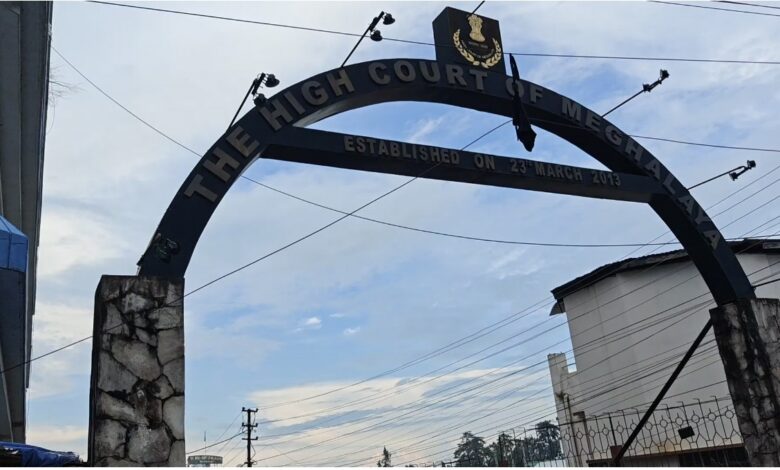No relief for ‘tainted’ candidates in HC order

Shillong, Sept 4: The order of the single bench of the High Court of Meghalaya, headed by Chief Justice IP Mukherji, has not given relief to the ‘tainted’ candidates who were deprived of jobs following the education scam.
Tainted and non-tainted categories of candidates were segregated by a high-level committee following the high court order in the past.
The court on Thursday considered the petitions and gave relief only to the three accused – Cabinet Minister Ampareen Lyngdoh, former education official JD Sangma and A Lyngdoh, leaving the tainted candidates in uncertainty for 17 years.
Out of 521, the candidature of 246 persons was cancelled because their selection was tainted.
“The scope of intervention by the Court in the application under Section 482 of the Code is extremely limited”, the court said.
Ampareen and Sangma are currently part of the NPP.
Ampareen happy with verdict
Ampareen hailed the judgment passed by the Meghalaya High Court discharging her from the alleged irregularities in a 17-year-old lower primary assistant teacher recruitment case.
Lyngdoh, who was former education minister, along with two other officers were accused of manipulating score sheets to favor certain candidates in the selection process for assistant teachers in Lower Primary Schools.
Addressing a press conference following the verdict, Lyngdoh expressed relief and gratitude, stating, “Lots of water under the bridge. I have suffered so much for 17 long years.”
“Today I remember my late mother, I told mom I didn’t do it but she was constantly pressured, she is no longer here to enjoy this beautiful day. I remember my late brother RG Lyngdoh who despite everything always told me that if you have not done it you will continue your service to the people.”
She thanked her family, supporters, and legal team, including Senior Advocate Salman Khurshid, for standing by her throughout the ordeal.
“Today’s verdict validates our stand. The name of Mr Peter Garnette Marbaniang is not in any way compromised. We are a family that upholds justice and that will service the people of the state to the best of our capacities,” Lyngdoh said.
Lyngdoh expressed her gratitude to the judiciary system, saying, “This country and nation will always fight for justice, and this is the justice I get today.”
She also thanked her supporters for believing in her and voting her back to office despite the allegations. Lyngdoh stated that would pray for those who wrongly accused her, saying, “God will grant me the grace to forgive each and everyone of you”.
“I am thankful to God and the Catholic church and the priests who continuously pray for my peace of mind… I am so sorry this case took shape the way it did, so sorry for the time that is wasted of all people who have become victims of this so-called white ink case,” she said.
The full text of the court verdict below
J U D G M E N T
The accused A1 and A2 have made separate applications under Section 482 of the Code of Criminal Procedure, 1973. They also seek quashing of the order dated 23rd August, 2022 passed by the learned Special Judge (CBI), East Khasi Hills district, Shillong, in applications made by them under Section 227 of the said Code. By the said impugned order, the learned Judge had dismissed the applications of the accused.
“Sections 227 and 482 are set out below:“
Discharge.– If, upon consideration of the record of the case and and the documents submitted therewith, and after hearing the submissions of the accused and the prosecution in this behalf, the Judge considers that there is not sufficient ground for proceeding against the accused, he shall discharge the accused and record his reasons for so doing.
Saving of inherent power of High Court.– Nothing in this Code shall be deemed to limit or affect the inherent powers of the High Court to make such orders as may be necessary to give effect to any order under this Code, or to prevent abuse of the process of any Court or otherwise to secure the ends of justice.”
In or about 2008, the State started a recruitment process for appointment of Assistant Teachers in the Lower Primary Schools.
A part of the selection process became the subject-matter of the complaint. This part concerned five centres or Sub-Divisions: (1) Shillong, (2) Jowai, (3) Amlarem, (4) Tura and (5) Dadenggre. The complainant, on 18th July, 2011 lodged an FIR with the criminal investigation Department of the State. It started a criminal case against Smti Mazel Ampareen Lyngdoh, the then Education Minister of Meghalaya-A1,
Shri J.D. Sangma, the then Director, Directorate of Elementary and Mass Education (DEME)-A2 and Smti Ameka I. Lyngdoh, the then Deputy Director, Directorate of Elementary and Mass Education (DEME) Shillong-A3.
Very broadly the accusation was that the accused conspired with one another, collaborated and manipulated the score sheets and other results of the selection process so that their favoured persons got the appointments. As a result, many eligible and successful candidates in the selection process were left out.
This case has a very chequered and long history. Initially in 2011, the case was registered under Section 408 IPC at Police Station, Laitumkhrah against A1 based on one complaint.
This Court by its order dated 2nd November, 2017 transferred the case to the Central Bureau of Investigation (CBI) which registered a case on 3rd January, 2018. It took the CBI two and a half years to file a chargesheet on 25th June, 2020. On the chargesheet, Sections 120-B read with 420, 467, 468, 471 and 201 were also included. Another period of more than two years two months was taken by the court to frame the chargesheet, on 25th August, 2022 and 31st August, 2022 respectively.
A few hundred witnesses were listed to give evidence for the prosecution. Considering the period during which this proceeding was pending and the further time required to examine all the witnesses, in this application, the investigating agency was requested by this Court to cut down the list. Ultimately, the list had been reduced to 181. Till date, only 28 witnesses have been examined.
About 17 years have passed since the selection process was initiated. Out of 521, candidature of 246 persons was cancelled on the ground that their selection was tainted.
The scope of intervention by the Court in the application under Section 482 of the Code is extremely limited.
Mr Salman Khurshid, learned Senior Advocate appearing for A1 and Mr K. Paul, learned Senior Advocate appearing for A2 cited some significant decisions of the Supreme Court in the application of Section 227 read with Section 482 of the Code. The relevant ones are briefly discussed hereunder:
In Baliya Alias Bal Kishan v. State of Madhya Pradesh reported in (2012) 9 SCC 696, the Supreme Court held as follows:
“17. The offence of criminal conspiracy has its foundation in an agreement to commit an offence or to achieve a lawful object
through unlawful means. Such a conspiracy would rarely be
hatched in the open and, therefore, direct evidence to establish the same may not be always forthcoming. Proof or otherwise of
such conspiracy is a matter of influence and the court in drawing such an inference must consider whether the basic facts i.e.
circumstances from which the inference is to be drawn have been proved beyond all reasonable doubt, and thereafter, whether
from such proved and established circumstances, no other conclusion except that the accused had agreed to commit and offence can be drawn. Naturally, in evaluating the proved circumstances for the purposes of drawing any inference adverse to the accused, the benefit of any doubt that may creep in must go
to the accused.”
In State of Tamil Nadu v. N. Suresh Rajan and Ors reported in (2014) 11 SCC 709, the same court opined as follows:
“29. We have bestowed our consideration to the rival submissions and the submissions made by Mr Ranjit Kumar
commend us. True it is that at the time of consideration of the applications for discharge, the court cannot act as a mouthpiece of the prosecution or act as a post office and may sift evidence
in order to find out whether or not the allegations made are groundless so as to pass an order of discharge. It is trite that at
the stage of consideration of an application for discharge, the court has to proceed with an assumption that the materials
brought on record by the prosecution are true and evaluate the said materials and documents with a view to find out whether
the facts emerging therefrom taken at their face value disclose the existence of all the ingredients constituting the alleged
offence. At this stage, probative value of the materials has to be gone into and the court is not expected to go deep into the matter and hold that the materials would not warrant a conviction. In our opinion, what needs to be considered is whether there is a ground for presuming that the offence has been committed and not whether a ground for convicting the accused has been made out. To put it differently, if the court thinks that the accused might have committed the offence on the basis of the materials on record on its probative value, it can frame the charge; though for conviction, the court has to come to the conclusion that the accused has committed the offence. The law does not permit a mini trial at this stage.”
In Dipakbhai Jagdishchandra Patel v. State of Gujarat (2019)16 SCC 547, the Supreme Court laid down the following law:“23. At the stage of framing the charge in accordance with the principles which have been laid down by this Court, what theb court is expected to do is, it does not act as a mere post office.
The Court must indeed sift the material before it. The material to be sifted would be the material which is produced and relied upon by the prosecution. The sifting is not to be meticulous in the sense that the Court dons the mantle of the Trial Judge hearing arguments after the entire evidence has been adduced after a fullfledged trial and the question is not whether the prosecution has made out the case for the conviction of the accused. All that is required is, the Court must be satisfied that with the materials available, a case is made out for the accused to stand trial. A strong suspicion suffices. However, a strong suspicion must be founded on some material. The material must be such as can be translated into evidence at the stage of trial. The strong suspicion cannot be the pure subjective satisfaction based on the moral notions of the Judge that here is a case where it is possible that accused has committed the offence. Strong suspicion must be the suspicion which is premised on some material which commends itself to the court as sufficient to entertain the prima facie view that the accused has committed the offence.”
In Vikramjit Kakati v. State of Assam reported in (2022) 17 SCC 249, its dictum was as follows: “9. Before we proceed to examine the matter on merits any further, it will be apposite to take note of the legal principles applicable seeking discharge, for which we may refer to a judgment of this Court in P. Vijayan v. State of Kerala reported in (2010)2 SCC 398, which has been further reiterated by this Court in the recent judgment in M.E. Shivalingamurthy v. CBI reported in (2020) 2 SCC 768 and discerned the following principles: (M.E. Shivalingamurthy case, SCC pp. 776-77, para17)“ 17.1. if two views are possible and one of them gives rise to suspicion only as distinguished from grave suspicion, the trial Judge would be empowered to discharge the accused. 17.2. The Trial Judge is not a mere post office to frame the charge at the instance of the prosecution. 17.3. The Judge has merely to sift the evidence in order to find out whether or not there is sufficient ground for proceeding. Evidence would consist of the statements recorded by the police or the documents produced before the Court. 17.4. If the evidence, which the Prosecution proposes to adduce to prove the guilt of the accused, even if fully accepted before it is challenged in cross-examination or rebutted by the defence evidence, if any, ‘cannot show that the accused committed offence, then, there will be no sufficient ground for proceeding with the trial.’ 17.5. It is open to the accused to explain away the materials giving rise to the grave suspicion.
17.6. The court has to consider the broad probabilities, the total effect of the evidence and the documents produced before the court, any basic infirmities appearing in the case and so on. This, however, would not entitle the court to make a roving inquiry into the pros and cons.17.7. At the time of framing of the charges, the probative value of the material on record cannot be gone into, and the material brought on record by the prosecution, has to be accepted as true.
17.8. There must exist some materials for entertaining the strong suspicion which can form the basis for drawing up a charge and refusing to discharge the accused.”
This Court has been shown by Mr Khurshid and Mr Paul, learned Senior Advocates for the petitioners, the score sheets at page 204 onwards of the petition which appear to have been prepared and signed by five officials, namely, the Director, Elementary and Mass Education; Member Secretary, DEME; Headmaster; Lecturer, DIET and an official of SDOIEAC. It was sent to accused No. 2 (A2) for checking and verification. He approved it. The score sheet at page 204 stated that it was prepared on the basis of “comparative working sheets.” Then I was taken to pages 197 onwards which represented the merit list prepared on the basis of this list. Learned counsel showed me the break-up of marks obtained by the candidate against Sl. No. 6 at page 197 of the merit list which matched the computation of scores in the said sheets against Sl. No. 30 at page 205. Then I was shown the final list of candidates rated ranking-wise at page 194. The contents of all the three sheets were identical. All were signed by the same officials.
Now, the case of the prosecution is that A1, A2 and A3 were in conspiracy, connivance and collaboration with one another. They had manipulated the score sheets, thereby, displacing the successful candidates by candidates of their choice. The original score sheets were different. White ink was used to erase the marks and substitute them by higher or lower marks as the case may be to accommodate the preferred candidates and to remove the undesirable ones. Furthermore, they had a charge against accused No. 1 that using her influence as minister she had furnished slips to the officers preparing the tabulation sheets directing alteration of marks.
First of all, the three documents showing various levels in tabulation of results were signed by the selfsame five persons.
Secondly, the said slips which had been produced as evidence could not by themselves suggest any specific direction for alteration of marks. The originals have not been produced as evidence.
No document showing interpolation or any application of white ink for erasing the marks are on record. The said slips which have been produced with some remarks of A1 could be for more than one purpose.
There is no further evidence to link those slips with the charge of manipulation of results.
Now, applying the principles laid down in the above Supreme Court decisions, if the prima facie case sought to be made out by the prosecution, from the documents, records and other evidence is so weak that a reasonable suspicion of the accused having committed the crime does not arise, the Court on consideration of this evidence is empowered to discharge the accused. In this case, the prosecution has failed to establish even a prima facie case from where a reasonable suspicion may arise in the prosecutor or the court of interpolation of the score sheets by the accused or any of them. The case or charges against each of them falls to the ground.
Under Section 482, this Court has the power to prevent “abuse of the process of any court or otherwise to secure the ends of justice.” The selection process is of 2008. About 17 years have rolled by. The first FIR was lodged on 18th July, 2011. Nothing has moved significantly in prosecuting the accused. Only 28 out of 181 witnesses have been examined. Such enormous delay in prosecuting a criminal case is also against the fundamental rights of the accused under Articles 21, 19 and 14 to lead a peaceful life free of mental anxiety caused by pendency of a criminal proceeding. At the rate it is proceeding examination of all witnesses, might take up the entirety of the remaining life of the
accused. Therefore, exercising power under Section 227 of the Code read with Section 482, especially the part which deals with the power ofthe court to prevent abuse of the process of any court or to secure the
ends of justice, I set aside the impugned order dated 23rd August, 2022 passed in Special (CBI) Case No. 2 of 2020 by the learned Special Judge (CBI), East Khasi Hills district, Shillong. The charges against the accused A1, A2 and A3 are quashed. The entire criminal proceedings are hereby quashed. Each of the accused 1, 2 and 3 are hereby discharged.
Crl. Petn. Nos. 36 of 2023, 37 of 2023, 70 and 71 of 2023 are allowed. Crl. Petn. No. 12 of 2023 is disposed of in terms of this order,without passing any order.
(I.P. Mukerji)
Chief Justice




